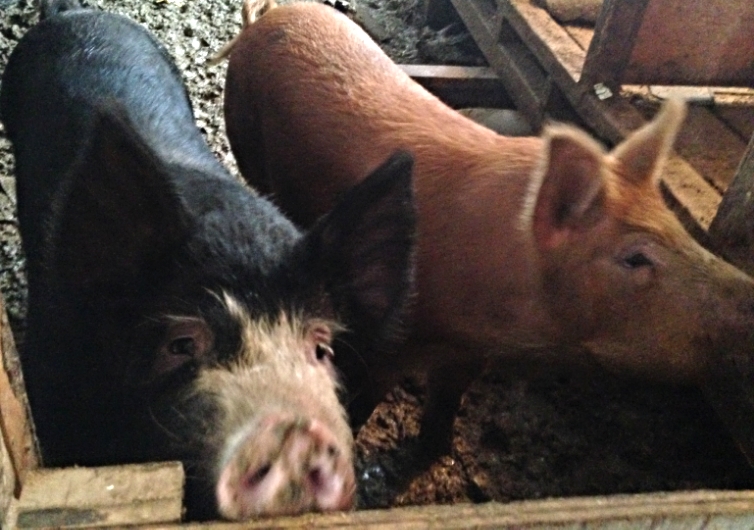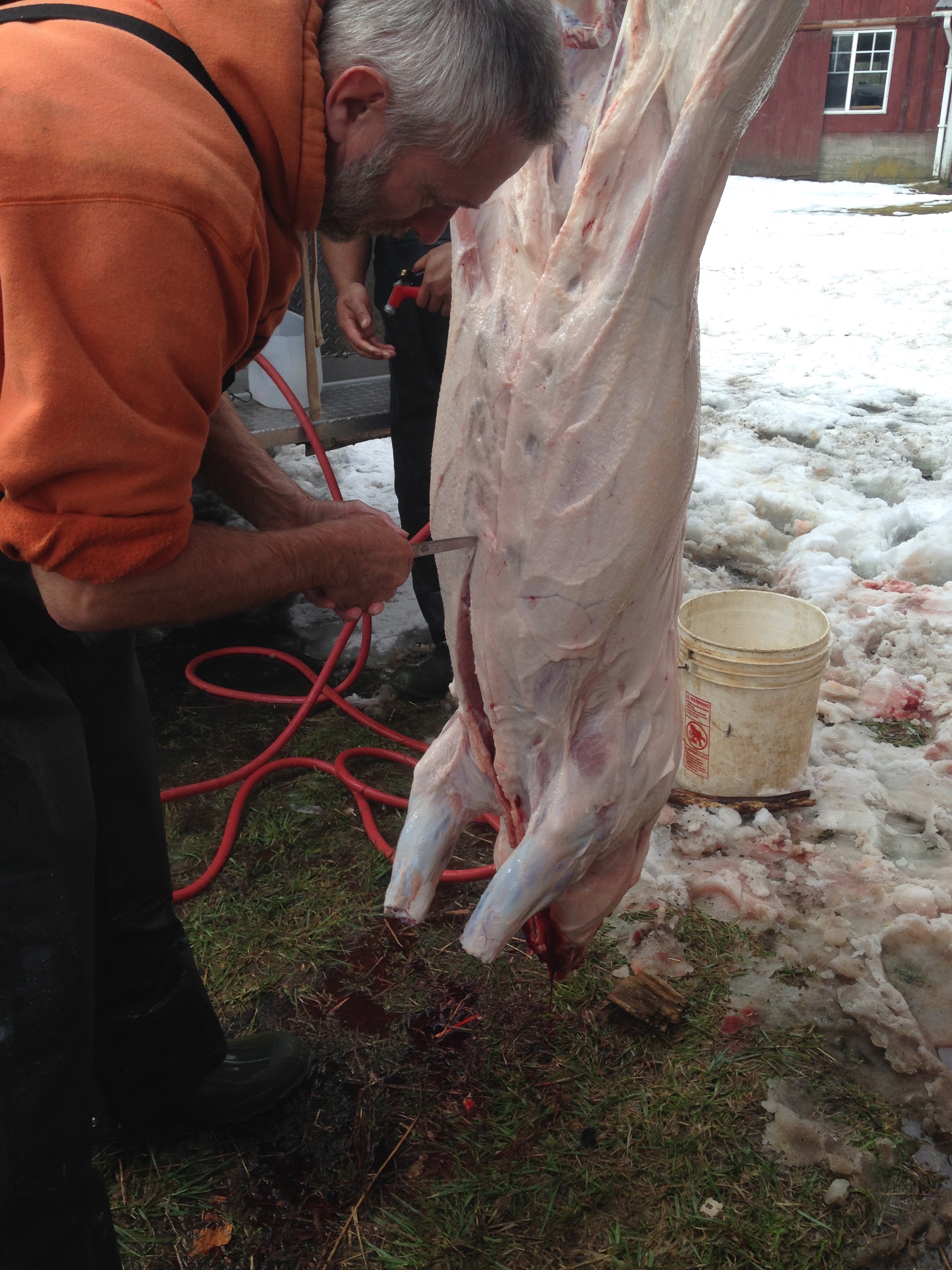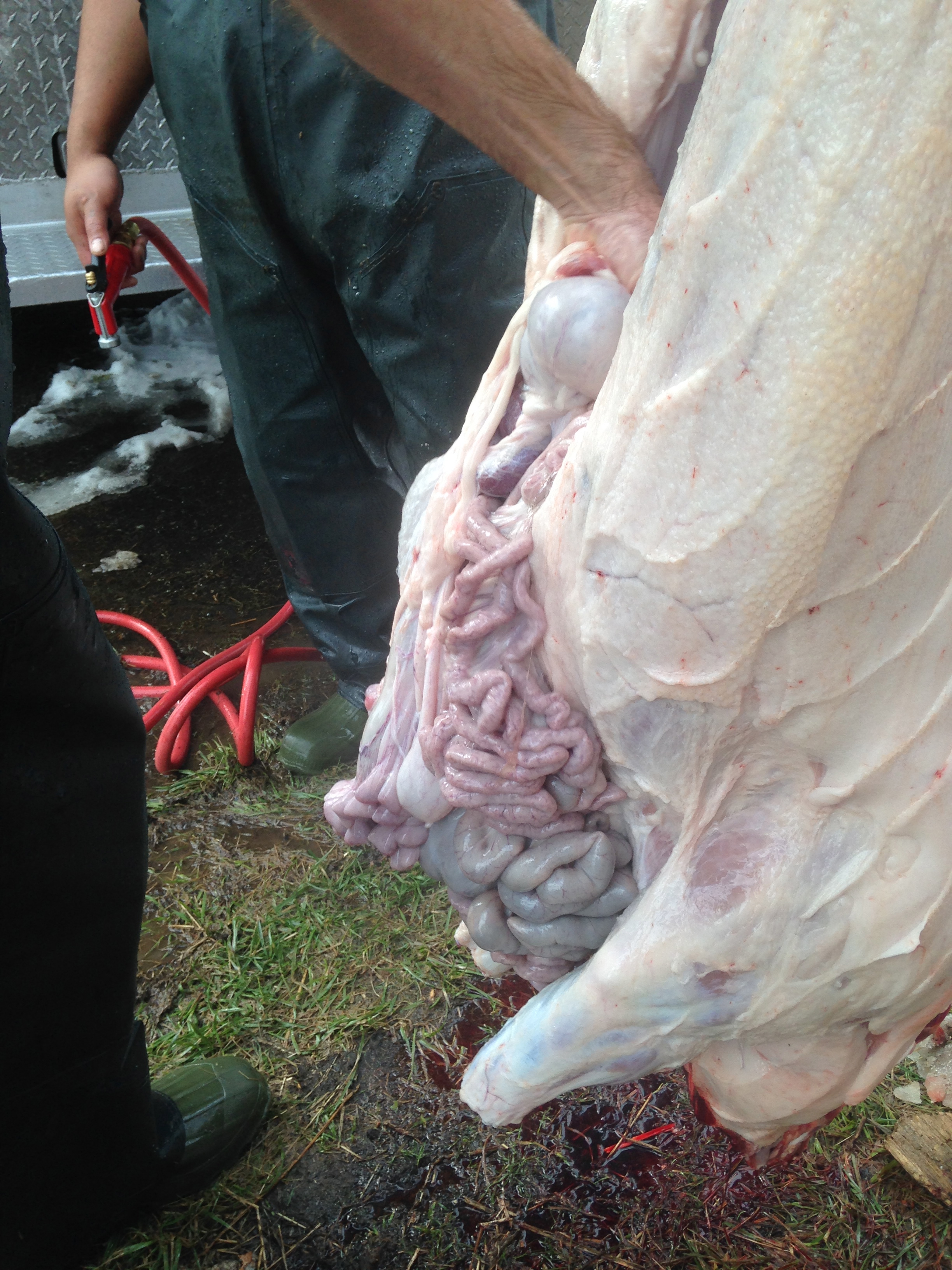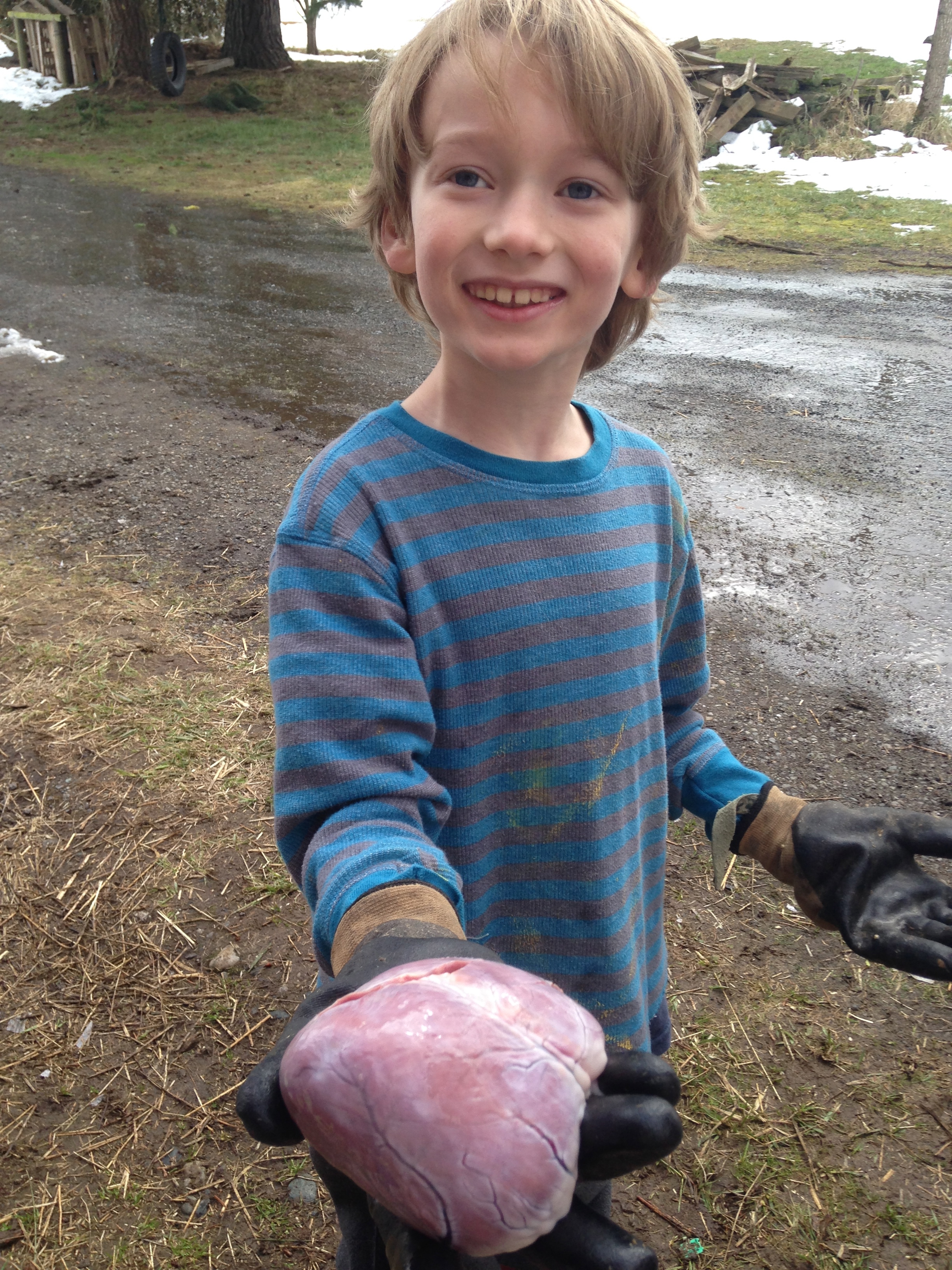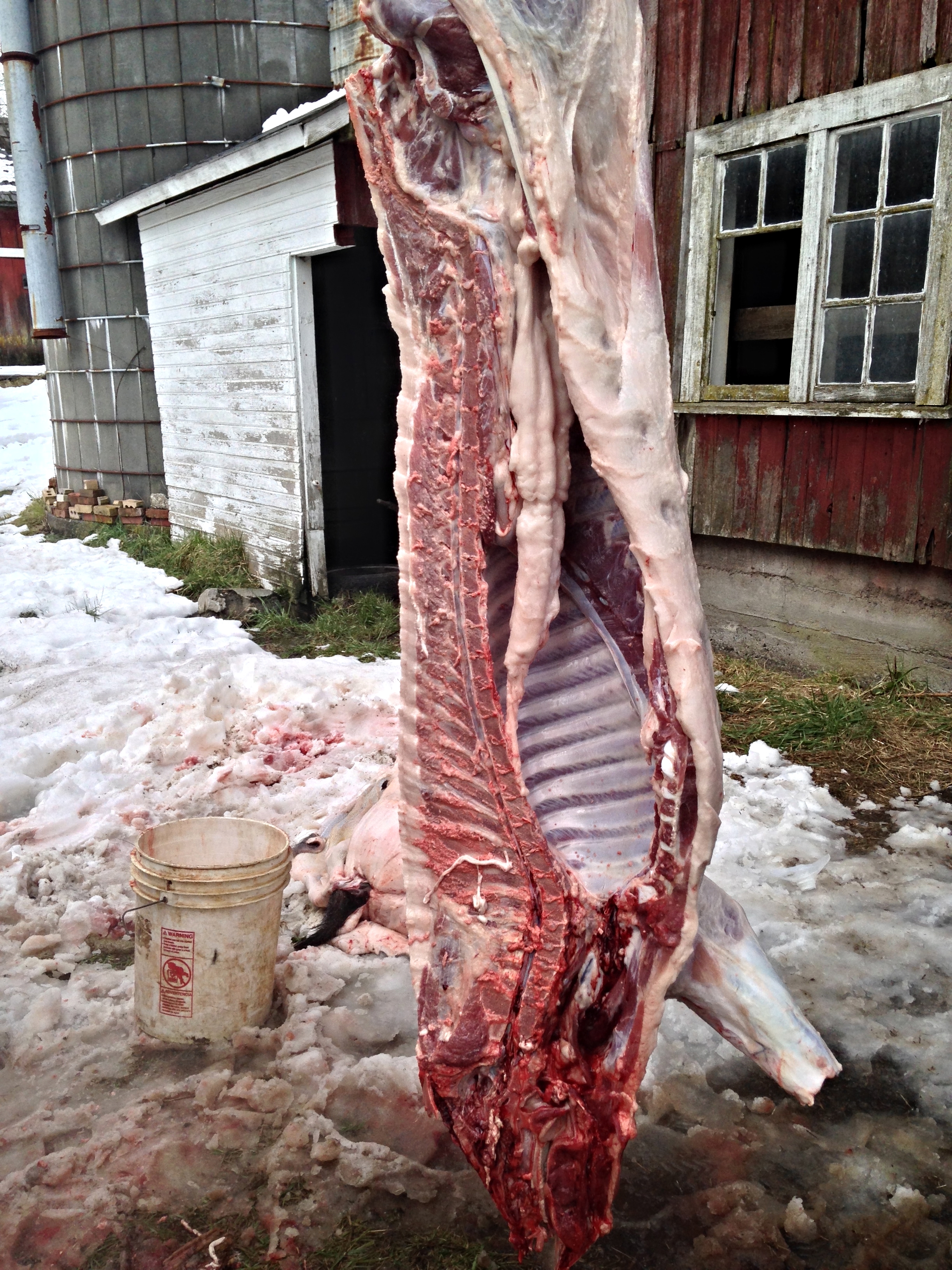Butchering Time
“Then one day Uncle Henry came riding out of the Big Woods. He had come to help Pa butcher. Ma’s big butcher knife was already sharpened, and Uncle Henry had brought along Aunt Polly’s butcher knife.
Near the pigpen Pa and Uncle Henry built a bonfire and heated a great kettle of water over it.
When the water was boiling they went to kill the hog.
Then Laura ran and hid on her bed and stopped her ears with her fingers so she could not hear the hog squeal. “It doesn’t hurt him, Laura,” Pa said. “We do it so quickly.” But she did not want to hear him squeal.
In a minute, she took one finger cautiously out of an ear and listened. The hog had stopped squealing.
After that, Butchering Time was great fun. It was such a busy day, with so much to see and do. Uncle Henry and Pa were jolly, and there would be spare-ribs for dinner, and Pa had promised Laura and Mary the bladder and the pig’s tail.”
The butcher's truck backed right up to the barn. The kids and I were nervous, but also really curious about the process.
So, today it was time for Poppy and Petunia to be turned into bacon and sausage.
This was our first time raising pigs. I had watched my father raise one pig, a big old mean guy named Redneck, on our farm when I was about 8 years old, and I still remembered the day Redneck was butchered.
I knew it would a visceral experience, literally, and it should be.
I try to buy only "clean" meat for my family, for many reasons: Health, both for the animals and the people who eat them. Sustainability. Kindness. A belief that antibiotics and hormones have no place in our food system. Snobbery, because I think meat raised with care and thought tastes better.
But clean meat is expensive, hard to find, and not always available. I am not a traditional farm wife, out in the wilds of Nebraska, 50 miles from town. My kids and I drive through the local coffee shop and get gluten-free sausage-and-egg breakfast sandwiches every so often. We eat at the breakfast buffet at hotels, and my kids load up on bacon. Sometimes I'll even buy cheap supermarket bacon, simply because my kids like it.
Poppy is the red one. Petunia is the black-and-white one. They're a Duroc-Berkshire mix, which is supposed to produce fabulous pork.
So we thought we'd come up with a source of clean meat for our family, a way to raise income for the farm, and a way to show our kids where their food comes from. Everyone who eats meat should know where it comes from, and what it looks like to raise an animal and eat it.
And so, last September, we bought two ten-week-old pigs from our neighbor, Allen. We have come to adore Allen and his pigs, and we're lucky to have him right down the street. He sold us two little fat pigs, who were very cute.
And very soon, Poppy and Petunia were NOT cute, and were not little. They were big, and they were scary, and it was time for them to go.
Poppy and Petunia's final picture.
Getting pigs in winter, of course, was just plain stupid: You have to buy most of their food, it's no fun to carry water out when the hose is frozen, and slipping in slushy pig mess is straight out of the sixth circle of hell.
And pigs are not lovable once they hit a certain size. They knock over food bowls and spill the food into the dirt, and then pee on it. They knock over their water. And they make it very clear that if you fell over while retrieving their water dish, they'd happily trample you and then eat you. There was no illusion that these two could ever be pets. They were not meant to be captive animals -- pigs in captivity have one purpose: To grow to market weight, and then be eaten.
The pigs that had been done this morning before ours.
So we were ready, we thought, when the truck showed up, but when they opened up the back, the reality set in: These were pigs that had been oinking this morning, and Poppy and Petunia were going to look like this very soon.
The reality is, that while we knew we raising animals for food, these were the same creatures that we'd been protecting and feeding, and scratching their noses, and keeping them safe. It was hard to admit that we were going to slaughter them.
But the guy with a gun was here, and he knew what he was doing. Two loud noises, one tiny squeal, two dead pigs that were being dragged out of the barn.
And after that, there was no going back. Squeamish or not, the pigs weren't coming back to life. It's time to figure out how to think of them as meat instead of pigs. And from here on out, things got pretty graphic.
Two loud noises and it was over.
The dead pigs were dragged out of the barn, into the snow, by the back of the truck. The truck had everything a serial killer's dreams are made of: Hooks, chains, sharp knives, a pulley system and a hose with a water tank to make all of the evidence go away. These guys have done this over and over again, and the expertise shows. The process was quick, professional and fascinating.
Petunia.
This was probably the worst part: Watching the pigs come out of the barn, dead.
Because they still looked like pigs, and we felt like we murdered them. There were a few tears and a little sniffling at this point.
After the guys shot the pigs, they immediately gashed a hole in the throat and let them bleed. It was hard to watch.
And then the skin started coming off, and we were all too intrigued to even be upset anymore.
The butcher used the skin of the pig as a tarp, to prevent any of the meat from coming in contact with the ground.
And the minute he sliced open the skin, it became clear that it was, in fact, meat. It stopped looking like a pig, and started looking like ribs, bacon and ham.
Scout was the most enthusiastic of them all. "This is awesome!"
The feet came off, and then carefully, with a knife the butcher sharpened over and over and over again, the skin fell away expertly toward the ground. And then it was time to hang the pig up, take out the guts, and finish the job.
Sander wanted to hold the heart, and we wanted to look at the guts, and Scout wanted to see the brain, and it was all interesting in a clinical, anatomical way.
But later, when it was all over, Sander sat on my lap and cried and asked about pig heaven. And he asked if he should feel guilty about holding the pig's heart and being interested in it.
And I told him what I truly believe: That everyone who eats sausage, or bacon, or who goes to McDonalds, ever, should hold a pig's heart. That they should know, exactly, and viscerally, what meat costs. That they should know that the cost of meat in our country is artificial: If you can buy an Egg McMuffin for 99 cents, and it has sausage on it, where do the pig farmers cut costs? If you're eating bacon at the hotel buffet, and one pig only has a few pounds of bacon on it when it's alive, how many pigs does it take to generate that amount of meat?
Ham doesn't come from a can.
“As soon as the hog was dead, Pa and Uncle Henry... hung the hog in a tree, took out the insides, and left it hanging to cool. When it was cool they took it down and cut it up. There were hams and shoulders, side meat and spare-ribs and belly. There was the heart and the liver and the tongue, and the head to be made into headcheese, and the dish-pan full of bits to be made into sausage.”
Pork is NOT a white meat. It should be expensive. It should be a treat. It should be valued. And there's nothing wrong with a little awe in the process. People have eaten pork for centuries. Domestic pigs exist only because they're tasty.
And it's important to know the toll that factory farming is taking on our planet, and if raising pigs helps my kids understand a little bit more about why going through the drive-through is almost always a bad idea, then we'll keep raising pigs.
But not in the winter. Because raising pigs in the middle of winter sucks.
So, we're done with our first round of pigs. We sold two halves, and we kept one whole pig for ourselves. The butcher will take the pig and turn it into hams, bacon, sausage and chops. I had to decide whether I wanted nitrates or no, spices or no, what kind of chops, smoked bacon or not. Next time, I might keep one half myself and see if I can break it down, and I'm already planning to make an old refrigerator into a meat smoker.
This has been a huge learning curve. But in the end, I think, it was something well worth doing.


